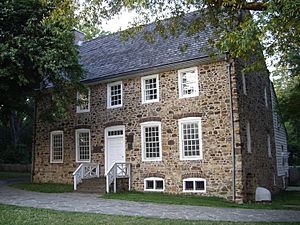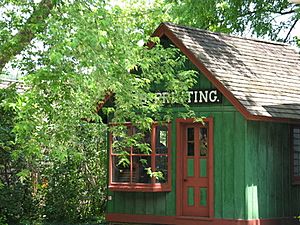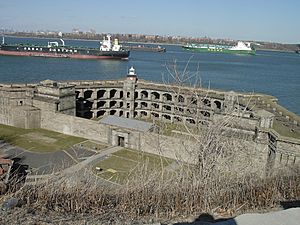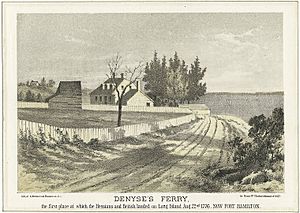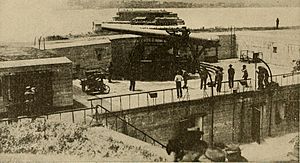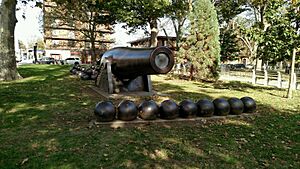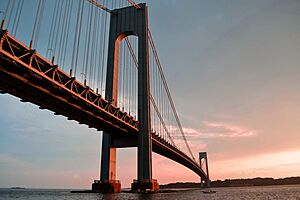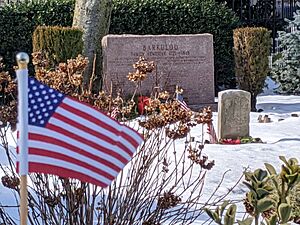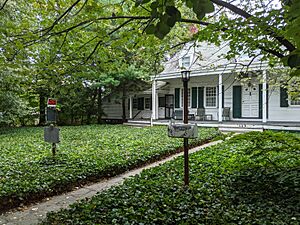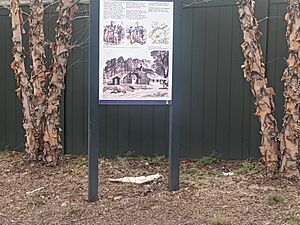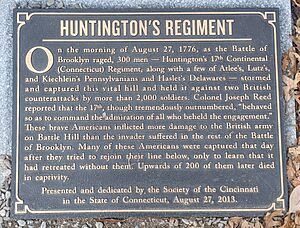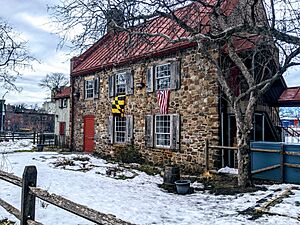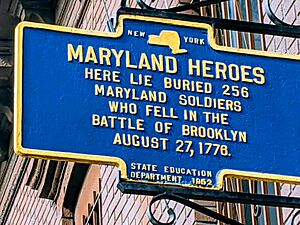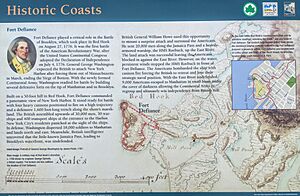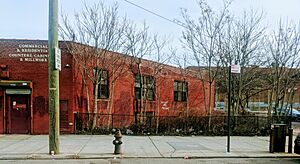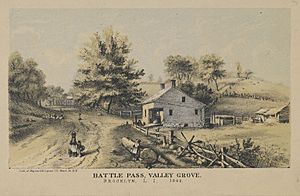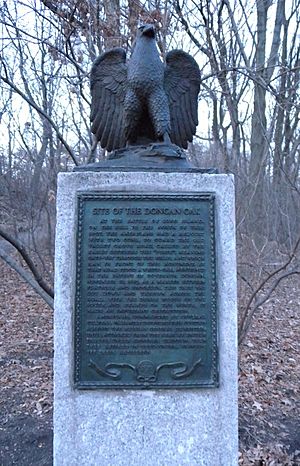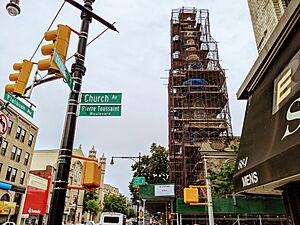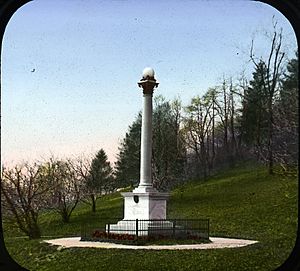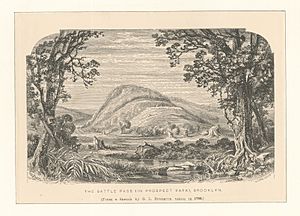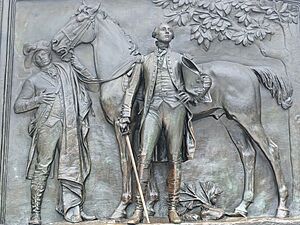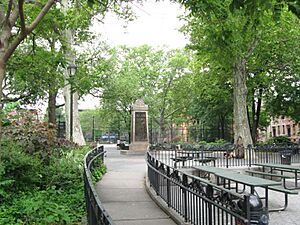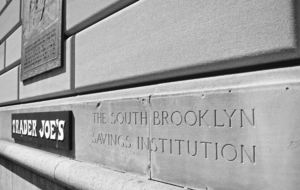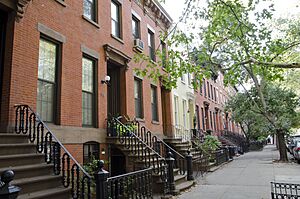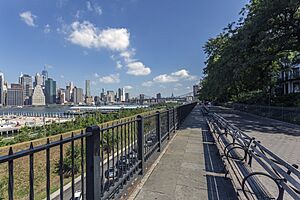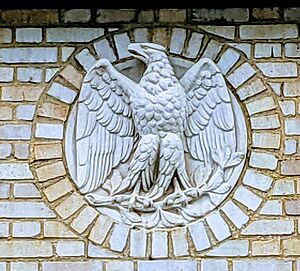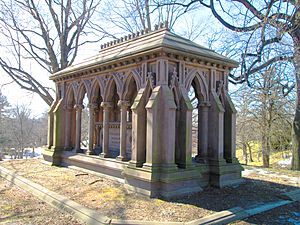Revolutionary War Heritage Trail facts for kids
This article lists important places on the Revolutionary War Heritage Trail in New York. These places played a big part in the American Revolutionary War, especially during the Battle of Long Island in 1776. Many organizations, like the New York State Office of Parks and the New York City Department of Parks, helped create signs and markers for these historic sites. They help us remember the brave people and important events from this time.
Contents
- Revolutionary War Sites in New York
- The Conference House
- Historic Richmond Town
- Fort Wadsworth
- Denyse’s Ferry
- Fort Hamilton Overlook - Harbor Defense Museum
- Fort Hamilton Overlook - Rodman Gun
- Verrazzano Bridge Underpass - Battle of Brooklyn Marker
- Barkuloo Cemetery
- Wyckoff-Bennett Homestead
- Red Lion Inn Site
- Battle Hill
- Old Stone House
- Maryland 400 Memorial
- Fort Defiance
- Red Hook Lane Arresick
- Battle Pass
- Dongan Oak
- Flatbush Reformed Protestant Dutch Church
- Grand Army Plaza
- Maryland Monument
- Lookout Hill
- Lafayette Memorial
- Fort Box Fortification
- Ponkiesberg Fortification
- Fort Greene Fortification
- Fort Stirling
- Fort Brooklyn
- Four Chimneys House Site
Revolutionary War Sites in New York
The Conference House
The Conference House is a historic stone house in Tottenville, Staten Island. In September 1776, important American leaders like Benjamin Franklin and John Adams met here. They talked with British Admiral Lord Howe to try and find a peaceful end to the war. But their meeting didn't work, and the war continued.
Historic Richmond Town
Historic Richmond Town is a large, 100-acre site in Richmond, Staten Island. It's like a living museum that shows what American life was like from colonial times to today. You can explore old houses and learn about history.
Fort Wadsworth
Fort Wadsworth is a very old military site in Fort Wadsworth, Staten Island. It's located at "the Narrows," a narrow waterway leading into New York Harbor. The British used this spot in August 1776 as a starting point for their huge invasion of Brooklyn. It was a very important place for controlling the harbor.
Denyse’s Ferry
Near Fort Hamilton, you'll find the site of Denyse’s Ferry. This is where a massive British army of 20,000 soldiers landed in August 1776. They came ashore from ships in Gravesend Bay, ready to fight in the Battle of Long Island. There's a historic marker here to remember this event.
Fort Hamilton Overlook - Harbor Defense Museum
The Harbor Defense Museum is a military museum inside a 19th-century fort at Fort Hamilton. It shows off old weapons, uniforms, and cannons. It's a great place to learn about military history.
Fort Hamilton Overlook - Rodman Gun
Also at Fort Hamilton, you can see a Rodman Gun. This huge cannon is a reminder of an early event in the war. On July 4, 1776, an American battery (a group of cannons) here fired at a British warship, the HMS Asia. This ship was bringing British troops to stop the American Revolution.
Verrazzano Bridge Underpass - Battle of Brooklyn Marker
Under the Verrazzano Bridge, near the waterfront bike path, there's a special marker. It tells the story of the Battle of Brooklyn. This area was very important during the Revolutionary War.
Barkuloo Cemetery
The Barkuloo Cemetery in New Utrecht is an old colonial burial ground. It was started by Dutch immigrants in 1725. Originally, two Revolutionary War soldiers were buried here, along with 19 other people.
Wyckoff-Bennett Homestead
The Wyckoff-Bennett Homestead in Madison is a historic Dutch Colonial house built before 1766. During the war, two Hessian soldiers (German soldiers fighting for the British) even carved their names into the windowpanes here before heading to Battle Pass. It's one of the last privately owned Dutch Colonial houses in New York City.
Red Lion Inn Site
The Red Lion Inn was a colonial tavern in Gowanus. It's no longer standing, but a historic marker shows where it once was. This tavern was the site of the very first fight of the Battle of Long Island on August 27, 1776.
Battle Hill
Battle Hill is a high point in Gowanus, located within Greenwood Cemetery. It was a key spot in the Battle of Brooklyn, the largest battle of the Revolutionary War. American soldiers bravely defended this hill, allowing others to retreat. Historic markers here tell the story of this important fight.
Old Stone House
The Vechte–Cortelyou House in Park Slope is a reconstructed Dutch farmhouse. During the 1776 Battle of Brooklyn, American soldiers from Maryland fought a fierce battle here. Their brave stand allowed General Stirling's troops to escape to Brooklyn Heights.
Maryland 400 Memorial
Near the Old Stone House, on the American Legion Post building, there's a historic marker for the Maryland 400. These were brave Maryland soldiers who fought heroically during the Battle of Brooklyn. Many of them were killed or captured while protecting the American retreat, allowing General Stirling's army to escape.
Fort Defiance
Fort Defiance was a defensive fort in Roode Hoek. It was built on high ground in the marshland. This fort played a crucial role by stopping the British warship HMS Roebuck from joining the Battle of Long Island on August 27, 1776. A historic marker now stands in the park where the fort once was.
Red Hook Lane Arresick
Red Hook Lane Arresick was an old colonial road that went through the marshland. During the American retreat on August 27, 1776, a fight happened here. A historic street sign marks this important spot.
Battle Pass
Battle Pass in Prospect Park was a historic hill pass. It was a very important location during the 1776 Battle of Long Island. Hessian soldiers used this pass to try and surround American forces. A plaque in a rock and a historic marker tell the story of the intense fighting that happened here.
Dongan Oak
The Dongan Oak site in Prospect Park is marked by a historic plaque. This is where a large tree was cut down to block the advance of Hessian invaders during a skirmish on August 27, 1776. A new tree has been planted here as a memorial.
Flatbush Reformed Protestant Dutch Church
The Flatbush Reformed Protestant Dutch Church in Vlacke Bos was built between 1793 and 1798. It's believed that the bodies of American soldiers who died in the Battle of Long Island are buried underneath the church.
Grand Army Plaza
Grand Army Plaza in Park Slope is a large public space at the main entrance of Prospect Park. This area was originally a battlefield during the Battle of Long Island. The creation of Prospect Park itself was partly to remember the battles fought here during the War of Independence.
Maryland Monument
The Maryland Monument in Prospect Park is a tall granite pillar with bronze tablets. It honors the brave Maryland 400 soldiers who helped save the American army during the Battle of Long Island. Their sacrifice allowed many American troops to escape.
Lookout Hill
Lookout Hill in Prospect Park was another important site where the Maryland 400 made a stand. This hill helped protect the American retreat during the Battle of Brooklyn in 1776. The Maryland Monument is located at the base of this hill.
Lafayette Memorial
The Lafayette Memorial in Prospect Park honors Gilbert du Motier, Marquis de Lafayette, a French nobleman who became a major general in the American army. He was a great friend to America. The monument shows Lafayette with James Armistead Lafayette, a brave spy. Lafayette fought in many battles and helped the Americans win the war.
Fort Box Fortification
The Fort Box Fortification site in Cobble Hill, Brooklyn is now Carroll Park. This area once had strong defenses built by General Washington's army. The British later leveled these forts. Carroll Park now serves as a memorial to these important fortifications.
Ponkiesberg Fortification
The Ponkiesberg Fortification, also known as Fort Cobble Hill, is remembered by a historic marker on a building in Cobble Hill, Brooklyn. This fort, sometimes called the “Corkscrew Fort,” was built up by the Americans. From this high spot, General Washington could watch the British invasion of Gowanus in August 1776.
Fort Greene Fortification
The site of the Fort Greene Fortification is in Boerum Hill, Brooklyn. This large, star-shaped fort was named after General Nathanael Greene. It was the biggest fort on Long Island at the time. Although the fort was later leveled, it played a key role in the defense of Brooklyn.
Fort Stirling
Fort Stirling was a destroyed fortification on Columbia Heights, Brooklyn. It was also known as Fort Half-Moon. This fort had a great view of the harbor and was important for defense. A memorial placed by the Daughters of the American Revolution (DAR) marks this historic spot.
Fort Brooklyn
Fort Brooklyn was another destroyed fortification on Columbia Heights, Brooklyn. It was originally planned by the Americans but later abandoned. The British then built a large fort here, which they occupied until 1783. There is no marker for this fort today.
Four Chimneys House Site
The Four Chimneys House in Brooklyn Heights, Brooklyn, was General Washington's headquarters from August 27-29, 1776. It was here that a very important decision was made: to evacuate Long Island. The house is gone now, but a historic marker placed by the DAR remembers this crucial "Retreat Decision" House.


